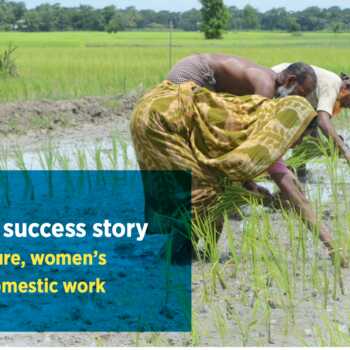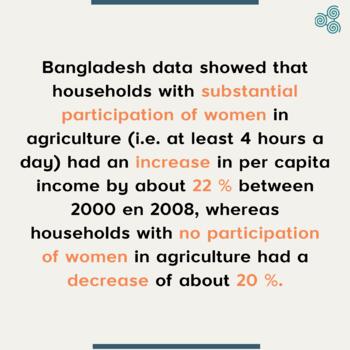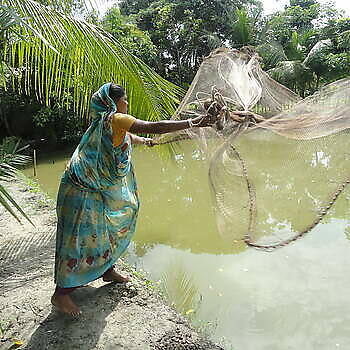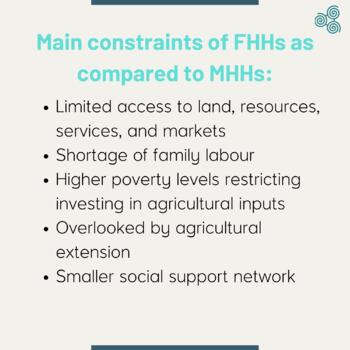Female headed households
Female headed households (FHHs) are defined as households where the primary decision maker is female due to the absence of an able adult male person capable of playing this role. These households often have only one adult person for ‘bread winning’, against at least two (husband and wife) in most male headed households (MHHs). De facto FHHs are those households where the male head is absent the majority of the time (e.g. because of migrant labour), but still may contribute to the household work or income, either through provision of agricultural labour on the family plot only in peak season and/or by sending home part of his salary as remittances. De jure female-headed households are those headed by widows or unmarried, divorced or separated women, without even an absent adult male member. Especially the latter category of FHHs belong to the poorest households in society, as they tend to have less access to land and other resources, whereas the female household head is also affected by ‘time poverty’, as she has to take care of all domestic and care work and all productive work.
Many countries in the developing world have a high prevalence of female-headed households. In Africa the proportion of FHHs as percentage of all households is generally the highest, with various countries with more than one third of all households being FHHs, such as Zimbabwe (45%), Namibia (44%) and Mozambique and Kenya (36%). Haiti and the Dominican Republique have also a high proportion of FHHS (41 and 40%), whereas several Asian countries also stand out, such as Nepal with 28% FFHs and Cambodia with 27%. Indonesia and Bangladesh have 15 and 13% FHHs, respectively. In the Middle East both Egypt and Jordan have 13% of all households as FHHs (source: Worldatlas).
Women farmers from FHHs often experience many constraints in agricultural production, as illustrated by two examples from recent Dutch funded projects in Ethiopia:
The Sesame Business Network project (SBN), aimed to improve the performance and incomes in the sesame sector. The proportion of female headed (farming) households was 20% in Amhara and 30% in Tigray. SBN reported more challenges for women and young farmers than for more adult male farmers to improve sesame production, for example, due to lack of collateral.
The CASCAPE project aimed to improve agricultural productivity through scaling up of evidence-based best practices. The CASCAPE gender analysis found more constraints for female headed households than for male headed households. FHHs, especially those without elderly sons, had more difficulties finding labour, because they have less family labour themselves and because men prefer to exchange labour with other men, not with women farmers. In all households children contribute substantially to family labour, but even more so in FHHs. Female headed households were often not targeted for agricultural extension, trainings or as ‘trial farmers’, “simply because they are forgotten”. As a consequence of all constraints, FHHs, especially those with younger children, had most problems producing enough food to feed their family.
Feminisation of agriculture: a trend in recent decades
Feminization of agriculture is the phenomenon that the importance of women’s role in agriculture is increasing, whether measured as the ratio between men and women working in this sector or whether reflected in the higher proportion of women whose main employment is agriculture. Though a global phenomenon, it is most pronounced in Africa and Asia, including in Bangladesh, but it shows important regional variations (see also Olivier de Schutter, 2013).
Common reasons for feminization of agriculture are men taking up non-farm employment locally, male out-migration from rural areas to urban areas or abroad, poverty, and/or women’s empowerment, such as through agricultural skill training and microcredit for agricultural production for women farmers by NGOs.
Evidence from Bangladesh: The 2011 paper of Jaim and Hossain used longitudinal panel data from surveys in 1988, 2000 and 2008 in Bangladesh, finding various forms of evidence of feminization of agriculture. Relevant findings and conclusions from their paper are:
- The percentage of adult women participating in agriculture remained almost the same in 1988 and 2000 (59%), but had increased considerably by 2008 (66%).
- Women’s involvement in crop production decreased because women’s traditional tasks (i.e. winnowing, parboiling, drying, and milling) became increasingly mechanised.
- The reduced involvement of women in crop production was substantially compensated by women’s increased involvement in livestock, poultry and homestead gardening. This has been significantly enhanced by NGOs and government promoting such IGA skills among women.
- Involvement of men in agriculture sharply decreased in 2000 as compared to 1988, mainly because of mechanization, including the increased availability of power tillers replacing men and bullocks. However, the 2008 data showed again (a slight) increase in male participation in agriculture (in terms of hours per day), mainly due to the intensification of crop production and livestock production activities.
- In terms of numbers the participation of female labour in agriculture changed quite drastically as compared to male labour. During the period 1999-2000 to 2005-2006 the male labour force for agriculture decreased from 16.2 to 15.1 million, whereas the female labour force in agriculture more than doubled from 3.8 to 7.7 million.
- The analysis of data also showed that households with substantial participation of women in agriculture (i.e. at least 4 hours a day) had an increase in per capita income by about 22% (in real price) between 2000 and 2008, whereas households with no participation of women in agriculture had a decrease of about 20%.
- This paper concludes that the trend of men moving into remunerative non-farm jobs will demand the participation of more women in agriculture in the near future.
Because women also take the brunt of all domestic and care work, feminization of agriculture tends to lead to overburdening of women. Without special measures, the negative impacts can outweigh the positive ones of increased production and chances for women’s empowerment (e.g. more decision-making). Without proper attention, feminization of agriculture can turn into ‘feminization of agrarian distress’.
Feminization of agriculture thus requires measures as the following:
- Agricultural extension should shift their focus more to women farmers, also in roles that previously were considered as male, such as farm management, marketing and interacting with information providers, thereby improving women’s access to inputs and resources, including credit.
- The burden of women’s agricultural work needs to be reduced by increasing productivity (efficiency) in women’s work and women’s access to innovations. When improving agricultural technologies, they should also be tested by women farmers to ensure they are also ‘women-friendly’.
- Special attention to reducing women’s workload in unpaid domestic and care work is imperative to avoid women being overloaded. This includes recognition, reduction and redistribution (i.e. sharing with all household members, including husband and sons) of domestic work.
- Female extension officers -next to male- are important both for better reaching out to female farmers and as role models.
Source of the quote on agrarian distress: Saying the right thing and following through: transforming gender relations in small scale agriculture. CGIAR / CCAFS, by Bruce M. Campbell, Sophia Huyer and Jayne Curnow, March 9, 2019



